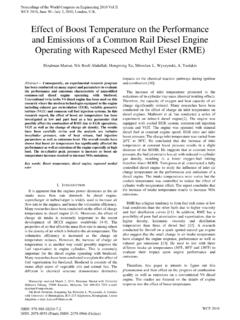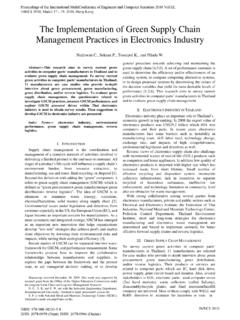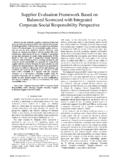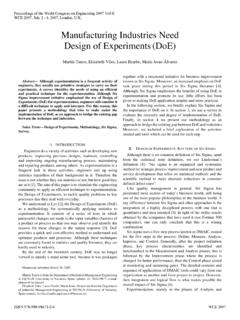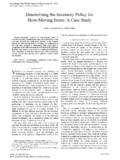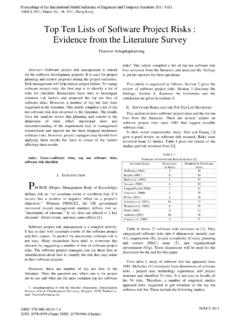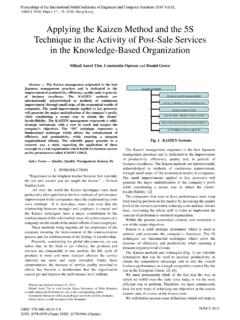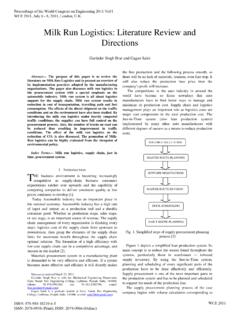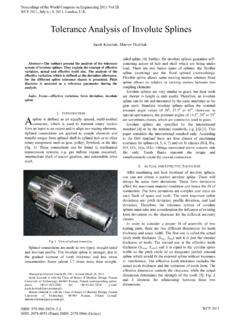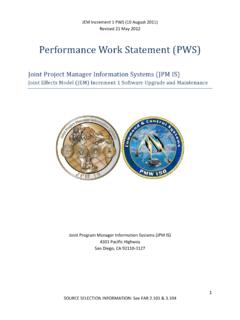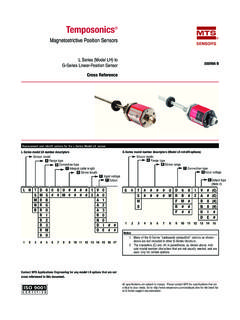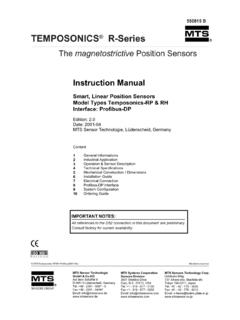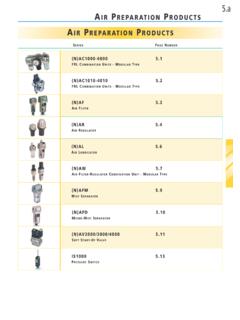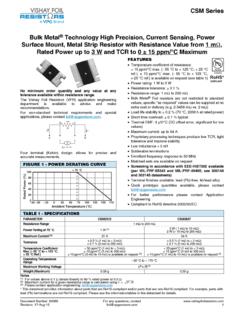Transcription of Achieving Success through Value Engineering: A …
1 Abstract In this paper we have discussed the concept of Value engineering , its job plan and the effective implementation of it through a case study. Efforts have been put into the articulation of the paper to make it coherent which can be easily perceivable. A case study has been discussed in this paper involving a part used in the medical instruments. The material is chosen such that the cost is reduced without affecting the quality of the product. The best feasible solution from the available alternatives is chosen through the feasibility ranking table. through the application of Value engineering profits are maximized without hindering the reliability of the product. With the effective utilization of the technique the final outcomes comes out to be a successful showcase of Value engineering . Keywords Functional Analysis, LCC, Job Plan, Value engineering , Value Index, ` (Indian National Rupee) I.
2 INTRODUCTION alue engineering is an organized/systematic approach directed at analyzing the function of systems, equipment, facilities, services, and supplies for the purpose of Achieving their essential functions at the lowest life-cycle cost consistent with required performance, reliability, quality, and safety[1]. Society of Japanese Value engineering defines VE as: A systematic approach to analyzing functional requirements of products or services for the purposes of Achieving the essential functions at the lowest total cost [2]. Value engineering is an effective problem solving technique. Value engineering is essentially a process which uses function analysis, team- work and creativity to improve Value [3]. Value engineering is not just "good engineering ." It is not a suggestion program and it is not routine project or plan review. It is not typical cost reduction in that it doesn't "cheapen" the product or service, nor does it "cut corners.
3 " Value engineering simply answers the question "what else will accomplish the purpose of the product, service, or process we are studying?"[4]. VE technique is applicable to all type of sectors. Initially, VE technique was introduced in manufacturing industries. This technique is then expanded to all type of business or economic sector, which includes Manuscript received June 30, 2012 Amit Sharma is with the Department of Production engineering in PEC University of Technology Chandigarh (phone:+919041293477; Belokar, is with the Department of Production engineering in PEC University of Technology, Chandigarh (Corresponding author phone: +91-172-2753287; construction, service, government, agriculture, education and healthcare [5]. II. HISTORY OF Value engineering During World War II, many manufacturers were forced to use substitute materials and designs as a result of critical material shortages.))
4 When the General Electric Company found that many of the substitutes were providing equal or better performance at less cost, it launched an effort (in 1947) to improve product efficiency by intentionally and systematically developing less costly alternatives. Lawrence D. Miles, a staff engineer for General Electric, led this effort. Miles combined a number of ideas and techniques to develop a successful methodological approach for ensuring Value in a product. [6] The concept quickly spread through private industry as the possibilities for large returns from relatively modest investments were recognized. This methodology was originally termed Value analysis or Value control. In 1957, the Navy s Bureau of Ships became the first Department of Defense organization to establish a formal VE program. Miles and another General Electric employee, Raymond Fountain, set up the Bureau of Ships program to help reduce the cost of ship construction, which had nearly doubled since the end of World War II.
5 The Bureau of Ships asked that the technique be called Value engineering and staffed the office with people under the general engineer position description. III. WHAT Value engineering ISN'T Value engineering is not just "good engineering ." It is not a suggestion program and it is not routine project or plan review. It is not typical cost reduction in that it doesn't "cheapen" the product or service, nor does it "cut corners." Value engineering simply answers the question "what else will accomplish the purpose of the product, service, or process we are studying?" It stands to reason that any technique so useful should be applied to every product, and at each stage of the normal day-to-day development of a highway product. This is not the case. The practice of VE entails a certain amount of expense, that must be justified by potential cost savings. Accordingly there must be a recognized need for change and a distinct opportunity for financial benefit to warrant the added cost of a VE effort.
6 Achieving Success through Value engineering : A Case Study Amit Sharma, Belokar, Member, IAENG VProceedings of the World Congress on engineering and Computer Science 2012 Vol II WCECS 2012, October 24-26, 2012, San Francisco, USAISBN: 978-988-19252-4-4 ISSN: 2078-0958 (Print); ISSN: 2078-0966 (Online)WCECS 2012 IV. USING LIFE-CYCLE COSTING WITH Value engineering The concept of economic analysis, which is used in life-cycle costing, requires that comparisons be made between things similar in nature. In Value engineering all alternatives can be compared using life-cycle costing because the alternatives for each project component are defined to satisfy the same basic function or set of functions. When the alternatives all satisfy the required function, then the best Value alternative can be identified by comparing the first costs and life-cycle costs of each alternative. For many projects there is a viable sustainable development alternative or enhancement.
7 Sustainable development may include more recycled material contents, require less energy or water usage, reduce construction waste, increase natural lighting, or include other opportunities that contribute to an optimal facility. The Value engineering methodology can provide for the identification of alternatives, sustainable or eco-efficient design features, and traditional design features, on an equal playing field for comparison. Comparison of alternatives, or the process for identifying the best Value alternative, is accomplished using life-cycle costing along with first-cost estimates. Life-cycle costing will in most cases be able to accurately estimate the first-cost and the full life-cycle cost differentials of each alternative. [7] At this point tradeoffs and decisions can be made to balance environmental performance with total cost ( , initial, recurring, and nonrecurring) reliability, safety, and functionality.
8 When all alternatives are compared equally ( , apples to apples ), sustainable development technology and integration can then be fully evaluated for performance in the acquisition process. V. ROADBLOCKS TO COST EFFECTIVENESS The practice of VE doesn't imply that there may be intentional "gold plating," conscious neglect of responsibility, or unjustifiable error or oversight by the design team. VE simply recognizes that social, psychological, and economic conditions exist that may inhibit good Value . The following are some of the more common reasons for poor Value : 1. Lack of information, usually caused by a shortage of time. Too many decisions are based on feelings rather than facts. 2. Wrong beliefs, insensitivity to public needs or unfortunate experience with products or processes used in unrelated prior applications. 3. Habitual thinking, rigid application of standards, customs, and tradition without consideration of changing function, technology, and Value .
9 4. Risk of personal loss, the ease and safety experienced in adherence to established procedures and policy. 5. Reluctance to seek advice, failure to admit ignorance of certain specialized aspects of project development. 6. Negative attitudes, failure to recognize creativity or innovativeness. 7. Over specifying, costs increase as close tolerances and finer finishes are specified. Many of these are unnecessary. 8. Poor human relations, lack of good communication, misunderstanding, jealousy, and normal friction between people are usually a source of unnecessary cost. In complex projects, requiring the talents of many people, costs may sometimes be duplicated and redundant functions may be provided [8]. VI. VE JOB PLAN The Job Plan [9, 10] consists of the following sequential phases A. Orientation Phase In the orientation phase, the project is selected and those who are going to work the problem are familiarized with it [11].
10 B. Information Phase The team is made familiar with the present state of the project. All team members participated in a functional analysis of the project as a whole, and then of its component parts, to determine the true needs of the project. Areas of high cost or low worth are identified [12]. C. Functional Phase Function can be defined, as the use demanded of a part of a product and the esteem Value that it provides. These functions therefore make the product work effectively or contribute to the salability of the product. Functional analysis outlines the basic function of a product using a verb and a noun such as boil water as in the case of our kettle [13]. D. Creative Phase This step requires a certain amount of creative thinking by the team. A technique that is useful for this type of analysis is brainstorming. This stage is concerned with developing alternative, more cost effective ways of Achieving the basic function.
